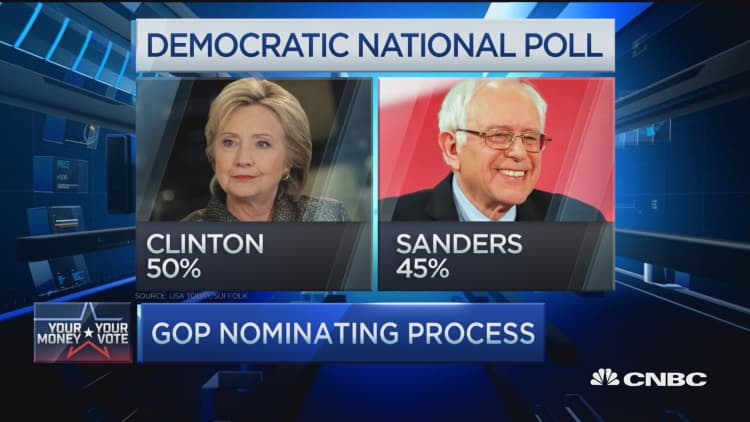


America's middle class is hollowing out.
In cities across the country from Seattle to Boston, the middle class is shrinking as more Americans either climb up into higher income brackets or slip further into lower income groups, according to Pew Research Center data released this week. In nine out of 10 cities, there are fewer middle-class families since 2000.
"These trends in the middle class are reflective of rising income inequality," said Rakesh Kochhar, associate director of research at the Pew Research Center. "This trend has been part and parcel of the national economy for the last 30 to 40 years."
From 2000 to 2014, the share of adults living in middle income households fell in 203 of 229 U.S. metropolitan areas, according to Pew's analysis of government data.
While it's known that rising income disparity is fueling the shrinking middle, the new analysis shows this national trend playing out in many cities — with the middle-class decline described as "often substantial," according to the report.
The drop in the middle-class share measured 6 percentage points or more in 53 metro areas, compared with a four-point drop nationally.
Drilling down further, the new data reveals the availability of a skilled local workforce and high quality jobs, whether tied to technology or the oil industry, can make or break the ability of families to accumulate wealth.
"Being skilled is useful," Kochhar said. "High tech will always rule up the income ladder. And global changes matter," he said.
In many ways, the vanishing middle reflects the patchiness of the recovery.
Not all Americans have fully rebounded from the Great Recession. The median income of U.S. households in 2014 was 8 percent less than in 1999.
While the national jobless rate stands at 5 percent, millions of Americans have simply dropped out of the workforce and aren't being counted. In April alone, those counted as not in the labor force surged by 562,000 to more than 94 million, according to the Bureau of Labor Statistics, which releases the monthly jobs report.
And as some Americans fall further through the cracks, others are accumulating more wealth.
The share of adults in upper-income households rose in 172 of the 229 metro areas. Plus, the share of adults in lower-income households rose in 160 metro areas from 2000 to 2014.
And to be clear, 108 metro areas saw growth in both lower- and upper-income groups.
Pew in 2014 defined middle class as a three-person household if its annual income fell between $42,000 and $125,000.
The income threshold was lower if there was a one-person household, while the income level was higher for homes with more than three people.
Areas with largest upper-income populations
Metro areas with the largest upper-income populations are mostly in the Northeast or California coast.
The exception to this rule is Midland, Texas, that leads the metro ranking of upper-income areas. The beneficial trigger was a booming global oil economy.
And not surprisingly, high-tech corridors also made this grouping of wealthier households including San Francisco and the Silicon Valley area. Hartford, Connecticut, a financial center, also made the cut.
And as noted by Kochhar, also an economist, people in upper income areas are more likely to have college degrees than in the nation overall.
Areas with biggest low-income tiers
On the flip side, farming communities in California's Central Valley were among the metro areas with the biggest lower income tiers, according to the report. Affected farming communities included Visalia, Porterville, Fresno and Merced, all in the valley also referred to as the San Joaquin Valley.
The agricultural complex is incredibly diverse with players that span packing housing down to armies of freelance crop pickers. California is the nation's largest agricultural producer and exporter. It grows more than a third of the country's vegetables, two-thirds of the nation's fruits and nuts.
The farming region in many ways encapsulates how income disparity plays out across the nation. While crop exports have soared in the past decade, lower skilled laborers suffer the most.
This low-income group also included the Southwest and border towns in Texas, according to the study. And many people in this low-income category are Hispanic.
Beyond regional trends at a national level, the evaporating middle class as a share of the population continues to lose ground.
As detailed in a December, 2015, Pew report, the share of American adults in middle-income households shrank to 50 percent in 2015 from 61 percent in 1971. America has been losing about 3 to 4 percentage points every decade.
"Now it's right on the border of 50 percent, neither majority or minority," said Kochhar of Pew. "But we're on a trajectory that is pointed down."
And for families on a downward slope, the climb up is harder than ever.
Just ask Melanie Faison, an affordable housing executive in Columbus, Georgia. Many of her clients are African-American families and include residents hit by cutbacks at the nearby Fort Benning Army base.
She sees firsthand how the rising cost of living drags down families, how student debt loads of $50,000 to $60,000 can prevent young adults from buying first-time homes and achieving other traditional hallmarks of adulthood and wealth accumulation.
"People in this area, incomes are depressed. Cost of food, everything, health insurance is going up," said Faison, executive vice president of the HomeOwnership Center for NeighborWorks Columbus. Her office pursues Federal Housing Authority loans for first-time homebuyers.
Said Faison: "For the working poor, it is harder and harder to survive."




